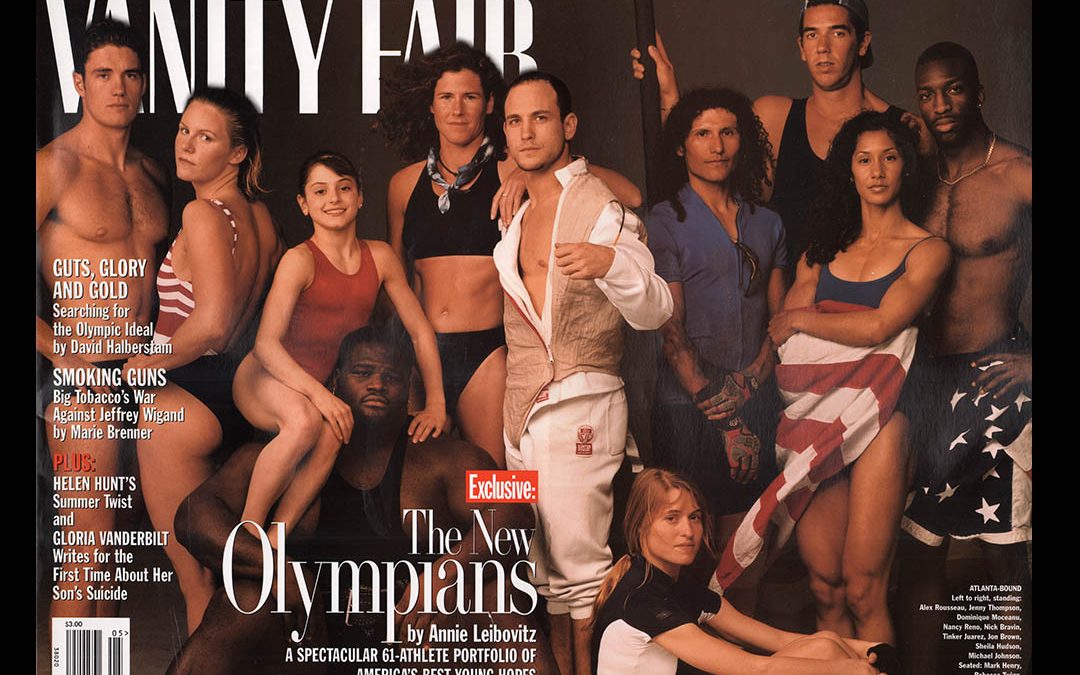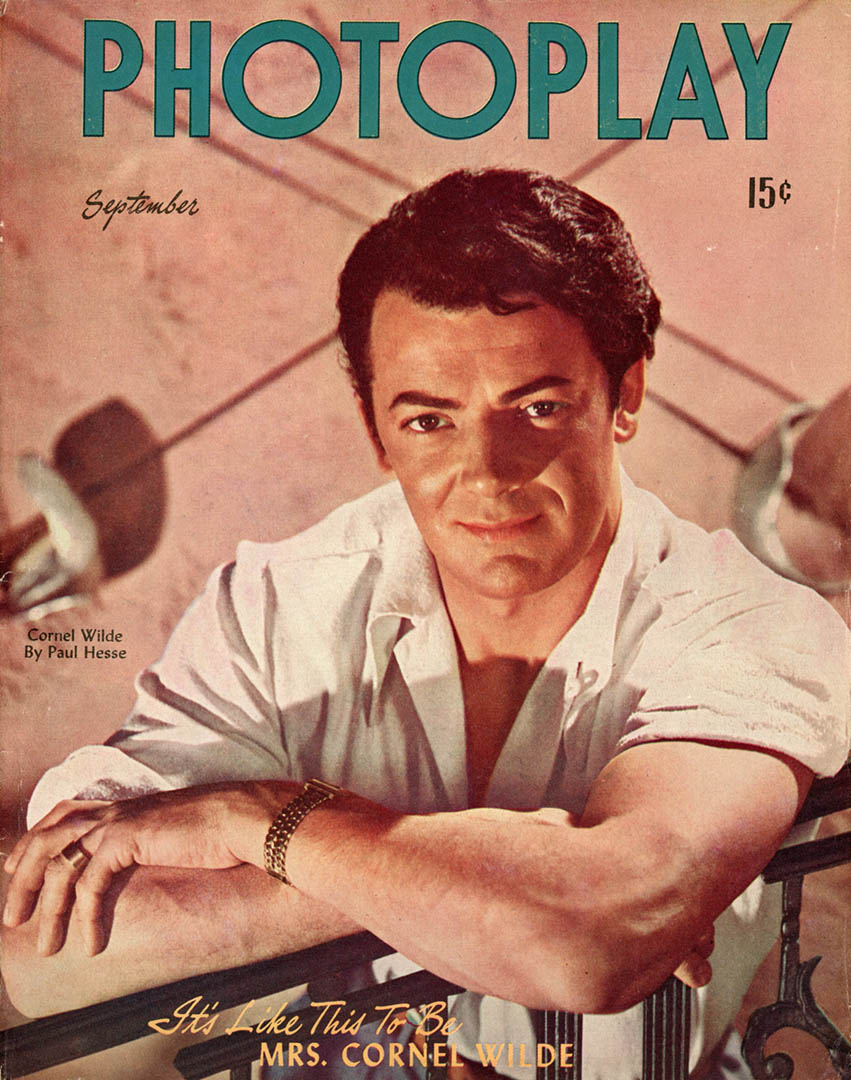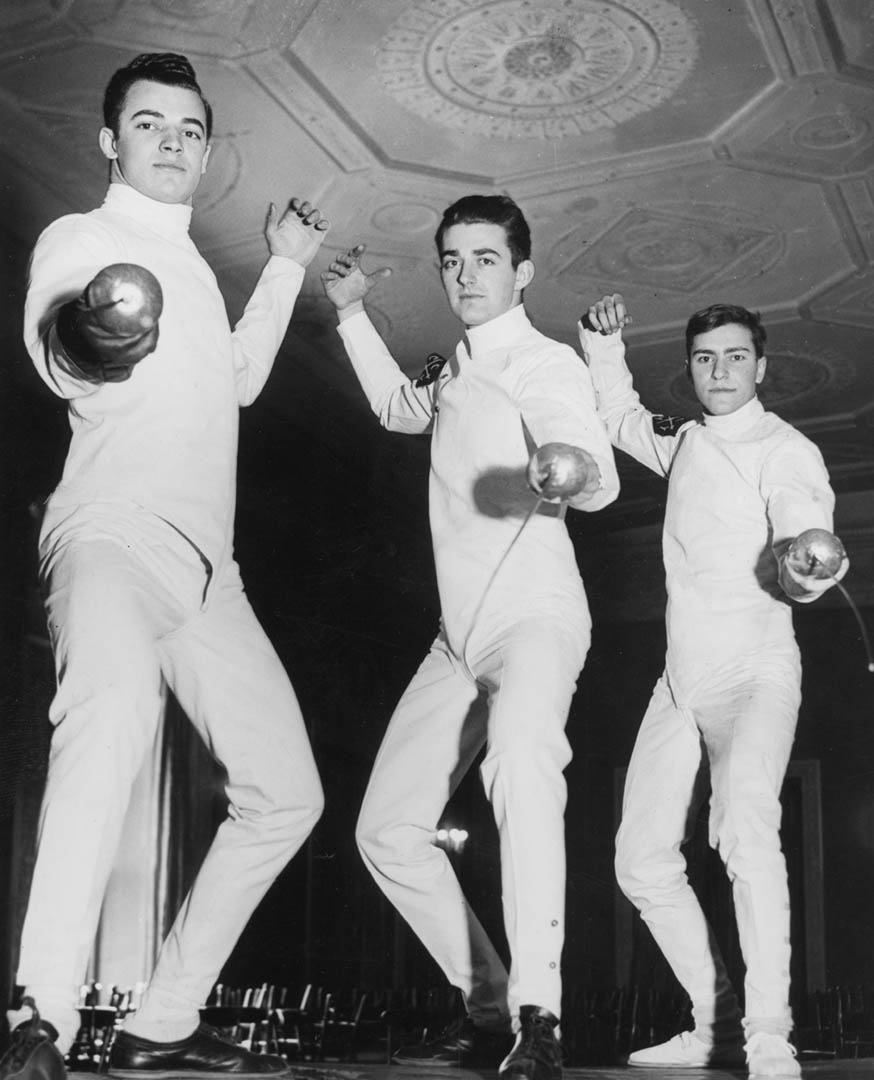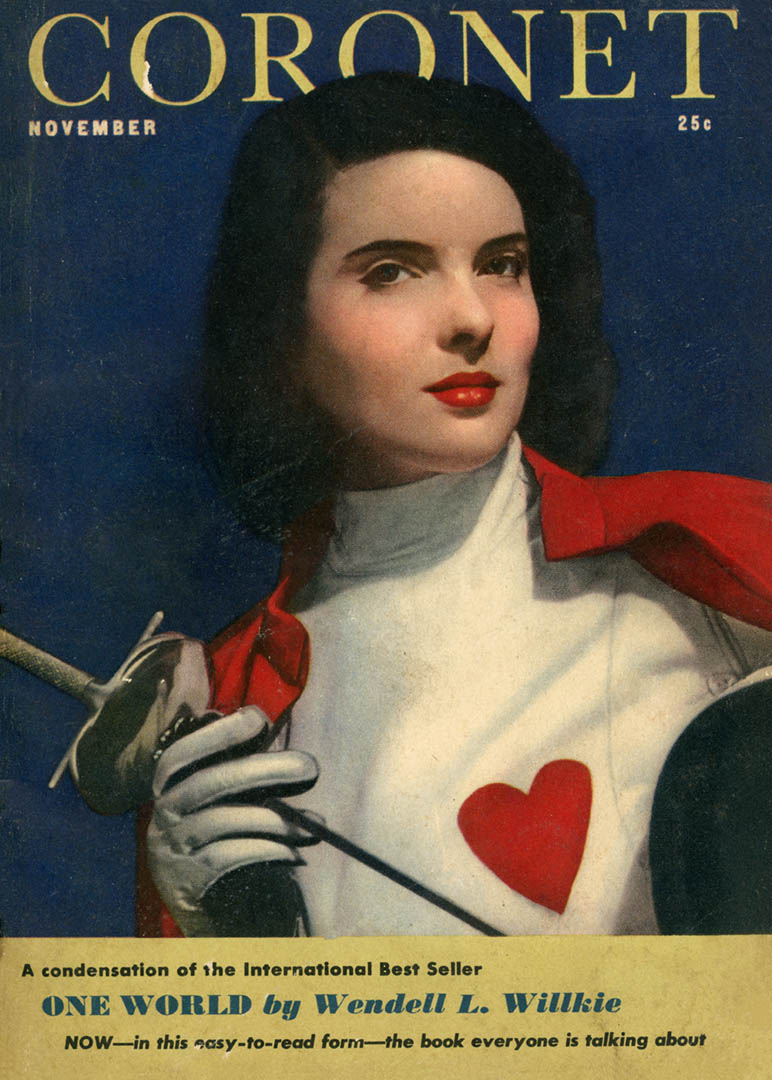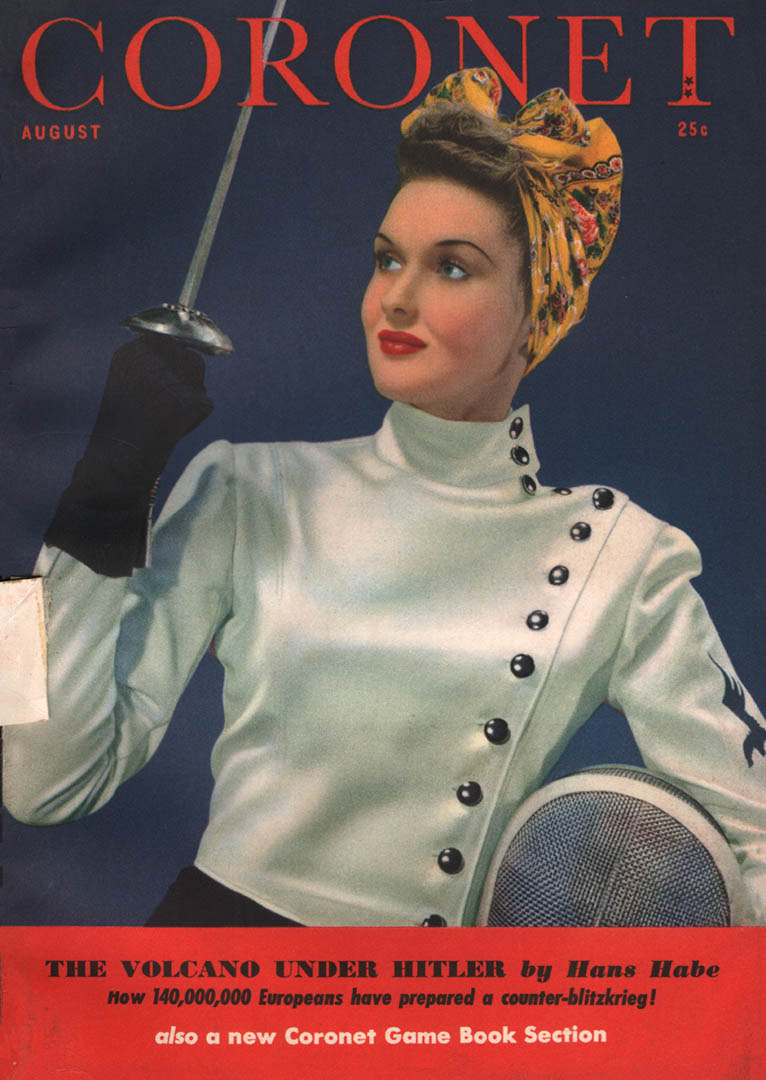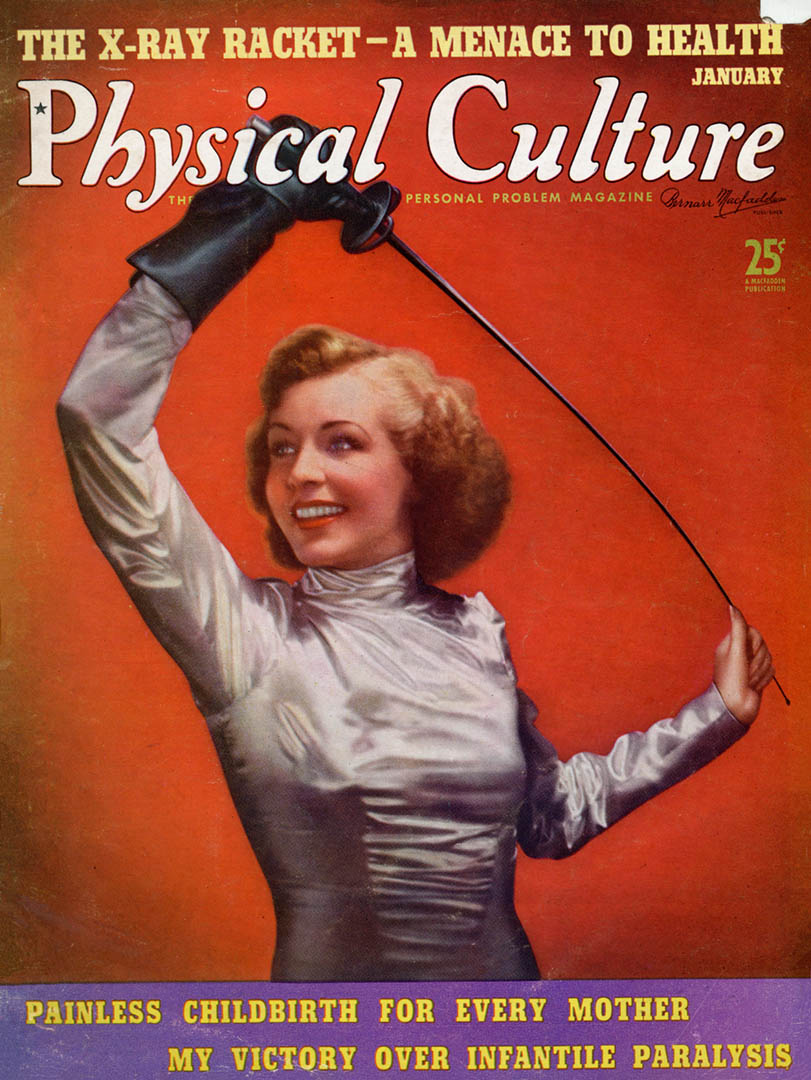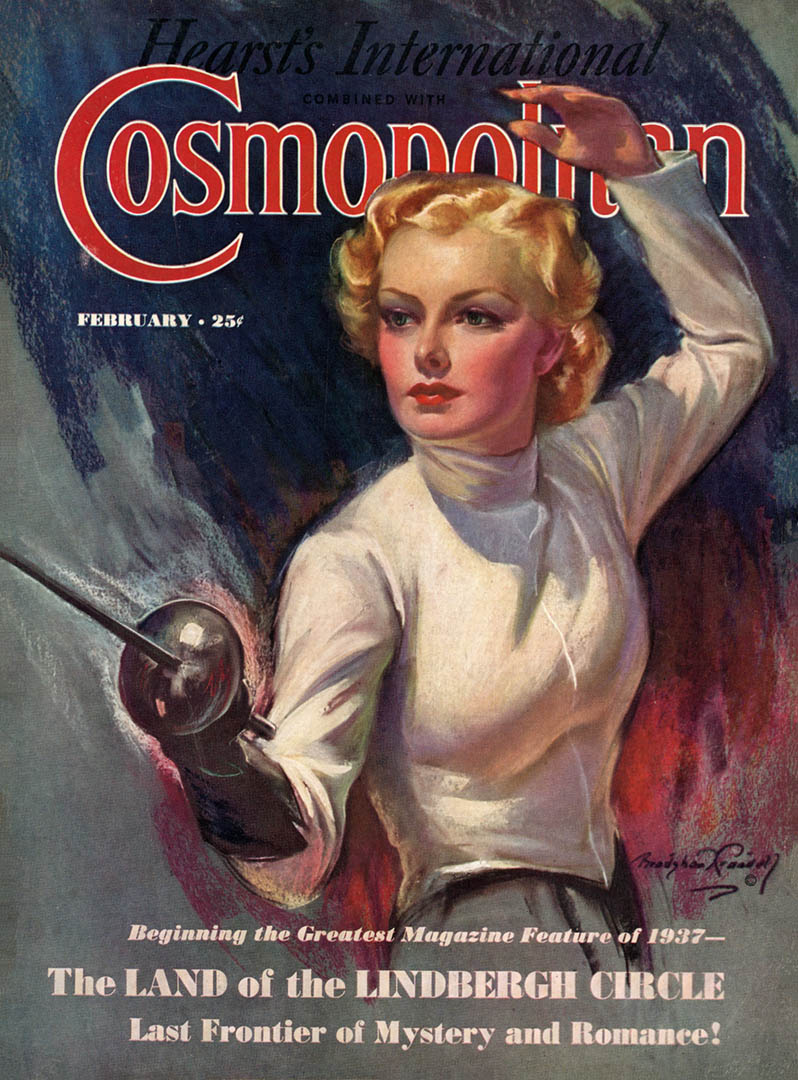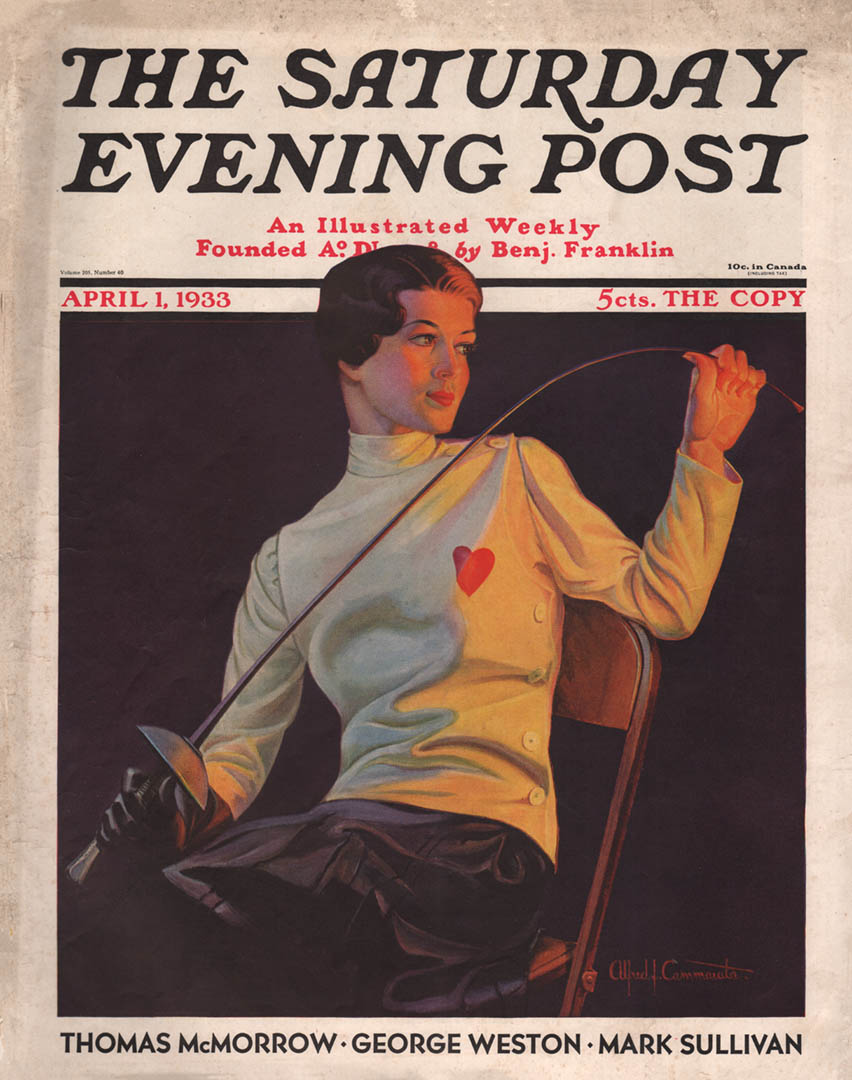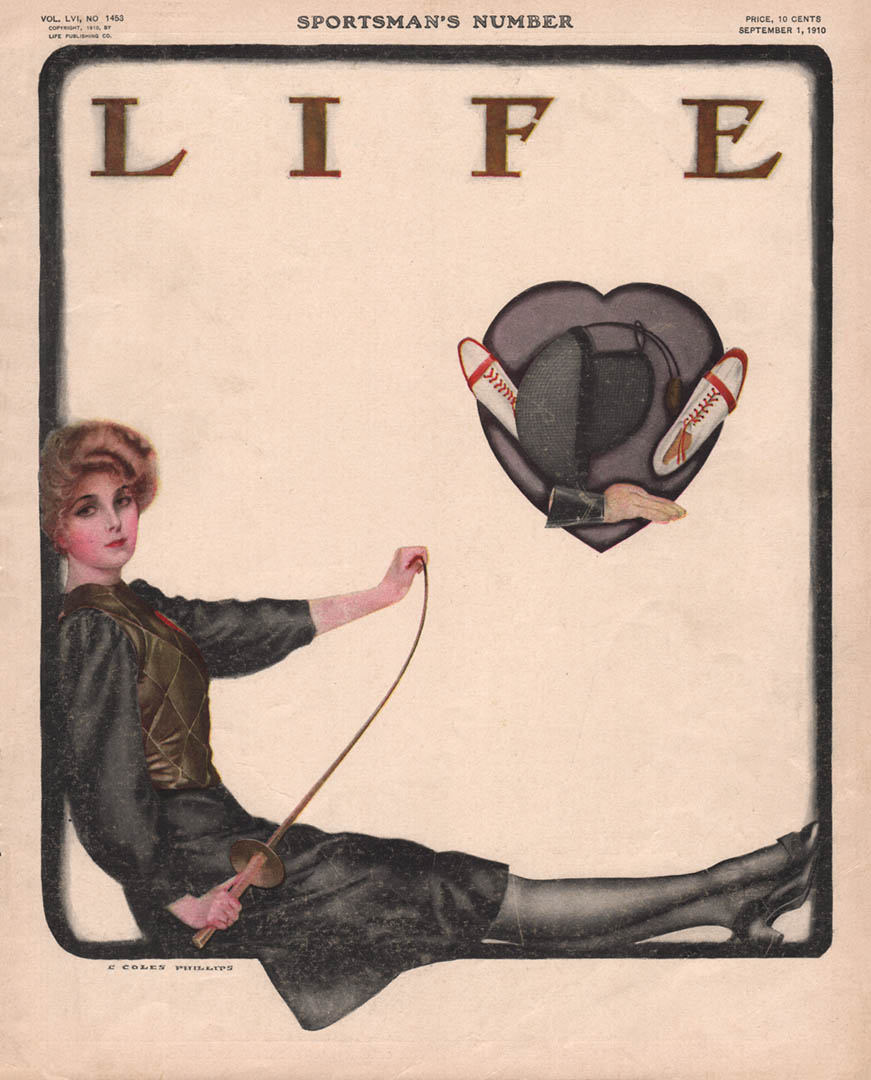It was graduation week for my schooled-by-Zoom High School Senior son this week, so I thought I’d put together an album of the best of the magazine covers featuring fencing from the Archive collection. I thought I’d go from most recent to oldest, so the date range is from 1994 – the one at the top – to 1910, which will be at the bottom. But don’t skip the middle! Great stuff ahead.
There are a lot of magazine inside pages that feature fencing, whether for an article or an advertisement, but for this exercise I decided to stick with covers. The Vanity Fair photo up top is pretty well known – arguably the only actually ‘well known’ image I’ve got to share today – and was taken by Annie Leibowitz for a multi-page feature on Olympic athletes. Nick Bravin is featured right in the middle here. The cover is actually a fold-out, so my copy had a seam going right through Nick from head to toe. It took a little touching up in Photoshop to get rid of the most obvious signs from that fold. Pretty happy with the result here. Nick made the cover of this issue, but on the inside for the article the featured fencer is Cliff Bayer. Getting two fencers in any major magazine is a pretty good run.
I just recently picked up this issue of Photoplay from 1946 with actor Cornel Wilde gracing the cover, but was disappointed to find that what is probably the big picture of him on the inside of this copy was torn out. So no other good pictures of Cornel. Not that I know whether he’d have been holding a sword in it – which would have been my reason for wanting it. Speaking of Cornel Wilde, did you know he was actually a champion foilist during college? He’s got to be one of the few swashbuckling actors that had a clue how to use a sword before becoming an actor.
The caption for this 1935 press photo is titled with: “Intercollegiate Foils Champs Hold Off Invaders.” It goes on to say: “The members of the College of the City of NY foils team, holders of the Iron Man Trophy, emblematic of Intercollegiate foils championship, pictured as they prepared to repel the invasion of other colleges taking part in the 42nd annual intercollegiate fencing championship. Left to right is Cornel Wilde, Emil Goldstein and Nathaniel Lubell.”
This squad from CCNY did indeed win the IFA championship in 1934, upsetting the favorites and thrilling their coach, Joseph Vince. Unfortunately, they were not able to hold on in 1935, losing out to NYU’s team that featured Hugo Castello and Norman Lewis. Hugo went on to coach at NYU and Norm Lewis won the US Foil title in ’39 and the Epee title three years in a row: 1948, 1949 and 1950. He was also on the 1948 Olympic team and became president of the AFLA. However, the CCNY squad wasn’t a pushover. Nate Lubell never won a US National title, but he was on three Olympic teams: 1948, 1952 and 1956, and took an individual bronze at the 1951 Pan Am Games, along with a team gold in both foil and sabre, and silver in team epee. He fenced on all three teams! For the CCNY team with Cornel Wilde? Lubell was the #2 man. At the 1935 IFA where they lost out to the NYU team, Wilde finished third in the individual behind Castello and Lewis from NYU. I’ve been wondering where to find a spot on this site to feature that picture of Cornel Wilde as a collegiate fencer ever since I picked it up. Now I know! Wilde, who played parts that took him to Sherwood Forest and inside the musketeer’s cloak as D’Artagnan Jr., likely could have cleaned up in a real swordfight among the raft of swashbuckling actors we all grew up with.
November of 1943 is the publication date of this issue of Coronet. There isn’t anything inside the issue at all related to fencing, just a lovely photo gracing the cover. Here’s the caption, describing the cover:
Equally charming in a fencer’s costume or in the incredible hats she models so well is Bettina Bolegard, Coronet’s November cover girl. Besides being a top notch model, the sloe eyed charmer has inherited her famous father’s talent for painting. Her versatility however, is all her own – and she managers her career and her five year old son with a capable and lovely hand. Salvos to Paule D’Ome for this striking Kodachrome.
Bettina Bolegard (real name Davis) was a well-known fashion model in the mid-40s into the early 50s. She retired from the work after the birth of her second child. She graced the cover of many magazines including Life and Vogue, and lots and lots of fashion features. The photographer of this shot, Paul D’Ome, was equally busy in fashion, producing a wide array of covers for Mademoiselle and many others.
Two in a row from Coronet, a magazine that covered any topic it could lay its hands on. I like this photo for a couple of reasons. The jacket looks shiny, like it’s made from satin or some other slick and highly not-protective-at-all material. However, that jacket is also sporting a Falcons patch from Ralph Faulkner’s Hollywood-based club. The photographer must have been borrowing some equipment for the shoot. This cover is from 1941 and the subtitle below the lady with a sword about the 140 million Europeans readying to strike back against Hitler, hoo-boy, did that not turn out. At least, not by 1941. The model’s name is Verna Knopf, who had a fairly successful thing going in Chicago before getting a gig that took her to Hollywood. She decided to stay and try acting and at the time this was taken, was enrolled in acting and singing classes. She’s got one mention on IMDB as an uncredited train passenger in the 1944 film “Since You Went Away” starring Claudette Colbert and Joseph Cotton. I guess the lessons didn’t bring the success she’d hoped for. The photographer, Laszlo Willinger, had a well-known photo studio in Austria where he was billed as Europe’s #1 glamour photographer. His mother had been a photographer, as well. After emigrating to the US, he set up shop in the Hollywood area and continued working with actors and actresses. In later years, he was accused, apparently correctly, with stalking a number of stars, particularly Charlie Chaplin. He was found to be in possession of thousands of “personal” photos of Chaplin. Go figure.
This wacky magazine from 1937 is a hoot. Subtitled “The Personal Problem Magazine’, I can’t help but wonder just how long it was in publication. Breaking the trend, this magazine does have a two page spread of fencers entitled, “Fence For A Fine Figure!” featuring women fencers from Salle Santelli. However, it also features articles titled, “Feminine Beauty Depends on Glandular Activity” and “Good Posture Begins in Babyhood”. As the cover suggests, there’s also an article about the menace of x-rays, but my favorite is all about “The Man Who Succeeded in Failing”, which can be found in the ‘Personal Problem Department’ on page 6. I haven’t started reading it yet, but if I get any good notes, I’ll be sure to share them.
The last three covers come from magazines that you may have actually heard of.
Cosmopolitan, circa 1937, painted by well-known “Painter of the Stars” Bradshaw Crandell. And he backed it up, doing portraits of Judy Garland, Bette Davis, Veronica Lake and Carole Lombard, among others. He’s in the Society of Illustrators Hall of Fame and his work sells today for pretty good sums.
But Cosmo will be Cosmo, so the inside of this magazine provides some pretty choice articles. Here are my favorite examples: “No Money in Her Purse”, “Debutante in Danger”, “Marry for Money” and my personal favorite, the mysteriously suggestive “Cocktails for Three”. I haven’t looked at an issue of Cosmopolitan for awhile, but I feel like they could update all these stories with a few references to modern technology and re-run them tomorrow. Maybe that’s exactly what they do. I should pick up a copy and see.
Of course, those are just the stories. The articles, which are all about telling you what to do and how, have some great titles, as well. One is simply titled, “Bend Your Knees”. After looking, it turned out to be an article about how to ski, so the title was probably the most useful advice in the whole article. But far and away my favorite is titled, “Look Eleven Years Younger” and features advice for the reader to avoid old-age mannerisms like The Famous Author Pose, The Bishop Pose and The Idiot Stare. It ends with a little nugget that is highly applicable today, but for different reasons. To avoid looking eleven years older – and to avoid the coronavirus – Don’t Touch Your Face!
I bought this 1933 issue of the Saturday Evening Post a long time ago at an antique store and have kept it in reasonably good shape, even while dragging it around through all my various changes of address. Not all of my long-time ephemeral material has fared as well as this one has. This painting was done by Alfred F. Cammarata, sometimes wrongly attributed as “Alfred P. Cammarata”. This particular work is all over the place if you’d like to buy a reproduction on sites ranging from Art.com to Walmart. Type in ‘fencer’ and ‘cammarata’ and take your pick. Cammarata worked mostly in comics, having a successful career during the Golden Age working on some pretty obscure books. Titles like ‘The Black Hood’, ‘Spectro’ and ‘Crime Crushers’, to name a few, all came his way. He signed his comic work as Al Camy’ – with that accent – so if you happen to be at a comic book convention, if they ever happen again, you can be on the lookout. He continued to work in comics into the 50’s for Fawcett, DC, Charleton and Harvey, so he got around. The above seems to be his most famous work, but maybe I just don’t know what else to look for.
And finally:
Another antique store find from long ago, this one I only have the cover for. I can’t, therefore, regale you with the interior contents and what the readers of Life were gleaning from the pages in 1910. I only know that when I saw this cover in the bin of magazine pages in that antique store, I checked my wallet to see if I had the $7.50 they wanted for it. I did. Charles Cole Phillips is the painter for this piece. Not long after this, he changed his signature from “Charles” or “C” Coles Phillips to just Coles Phillips. Working out of New Rochelle, NY, he was very well known and produced a great deal of work, but died young in 1927 at the age of 47. His work is frequently associated with other well known artists of the time like J.C.Leyendecker, who eulogized him at his funeral, Charles Dana Gibson and Norman Rockwell. He was described as having imbued his women subjects with a uniquely American quality.
That’s it for Picture Day! If you had a graduate in your family this year, congratulations to you, too! If not, you probably know one or two. Give them an extra hug or two. They’ve made it through a wacky end to their school year.

